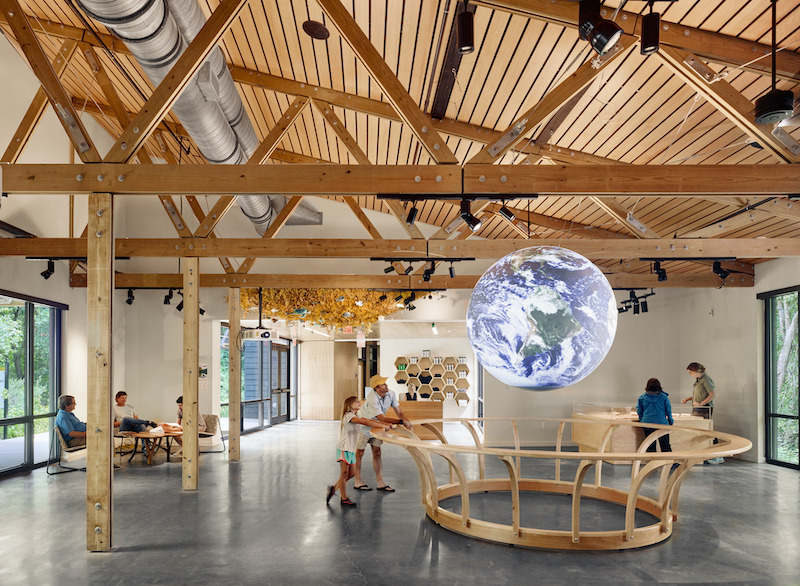The American Institute of Architects (AIA) Committee on the Environment (COTE) is announcing this year’s recipients for its highest honor, the COTE Top Ten Awards. Complete details for each project are available on AIA’s website.
COTE bestows the award annually on 10 design projects that have expertly integrated design excellence with cutting-edge performance in ten key areas. The COTE Top Ten winning projects illustrate the solutions architects provide for the health and welfare of our communities and planet.
In order to be eligible, project submissions are required to demonstrate alignment with COTE’s rigorous criteria, 10 measures that include social, economic, and ecological values. The five-member jury evaluates each project submission based on the effectiveness of their holistic design solution and metrics associated with the 10 measures. This year’s COTE Top Ten Awards recipients are as follows:
- Austin Central Library, Austin, Texas | Lake|Flato Architects + Shepley Bulfinch Joint Venture
- U.S. Land Port of Entry, Columbus, New Mexico | Richter Architects
- Etsy Headquarters, New York | Gensler
- Ford Foundation Center for Social Justice, New York | Gensler
- John W. Olver Design Building, Amherst, Massachusetts | Leers Weinzapfel Associates
- Keller Center - Harris School of Public Policy, Chicago | Farr Associates (Design Lead & Architect of Record) and Woodhouse Tinucci Architects (Collaborating Architect, Interior Designer)
- Marine Education Center at the Gulf Coast Research Laboratory, Ocean Springs, Mississippi | Lake|Flato Architects in association with Unabridged Architecture
- The Six, Los Angeles | Brooks + Scarpa
- UPCycle, Austin, Texas | Gensler
Jurors also designated one project as a Top Ten Plus recipient for its exceptional post-occupancy performance data. This year's recipient is:
- Environmental Nature Center and Preschool, Newport Beach, California | LPA, Inc.
Visit AIA’s website for more information on the COTE Top Ten Awards program.
In conjunction with COTE, the Association of Collegiate Schools of Architecture (ACSA) has selected the COTE Top Ten for Students, honoring exceptional student design projects showcasing innovation in sustainability. View the winning designs on ACSA’s website.
“The students being honored should be commended for their work and design intelligence. They provide great hope that future architects will have the skills and solutions to make our world better by integrating beautiful design with equitable climate action for human and ecological health,” said Julie Hiromoto, AIA, chair of COTE. “The COVID-19 pandemic has highlighted how necessary and valuable innovative design solutions are for healthy built environments.”
Since committing to environmental stewardship last year, architects have made notable progress in the climate action fight. Visit AIA’s website to learn more about all the climate action progress being made, including our first Climate Action Plan.
Related Stories
| May 15, 2014
First look: 9/11 Memorial Museum opens to first-responders, survivors, 9/11 families [slideshow]
The 110,000-sf museum is filled with monumental artifacts from the tragedy and exhibits that honor the lives of every victim of the 2001 and 1993 attacks.
| May 14, 2014
New study shows employees aren't happier working in green buildings
People working in buildings certified under LEED’s green building standard appear no more satisfied with their workplace environments than those in conventional buildings, according to new research from the University of California, Berkeley, and the University of Nottingham.
| May 14, 2014
Construction growth looking up: Gilbane Spring 2014 Economic Report
Construction spending for 2014 should finish 6.6% higher than in 2013, with nonresidential work contributing substantially.
| May 14, 2014
Prefab payback: Mortenson quantifies cost and schedule savings from prefabrication techniques
Value-based cost-benefit analysis of prefab approaches on the firm's 360-bed Exempla Saint Joseph Heritage Project shows significant savings for the Building Team.
| May 13, 2014
First look: Nadel's $1.5 billion Dalian, China, Sports Center
In addition to five major sports venues, the Dalian Sports Center includes a 30-story, 440-room, 5-star Kempinski full-service hotel and conference center and a 40,500-square-meter athletes’ training facility and office building.
| May 13, 2014
Drexel University case study report: Green Globes cheaper, faster than LEED
GBI’s Green Globes certification process is significantly less expensive to conduct and faster to complete than LEED certification, says Drexel prof.
| May 13, 2014
Steven Holl's sculptural Institute for Contemporary Art set to break ground at VCU
The facility will have two entrances—one facing the city of Richmond, Va., the other toward VCU's campus—to serve as a connection between "town and gown."
| May 13, 2014
Universities embrace creative finance strategies
After Moody’s and other credit ratings agencies tightened their standards a few years ago, universities had to become much more disciplined about their financing mechanisms.
| May 13, 2014
19 industry groups team to promote resilient planning and building materials
The industry associations, with more than 700,000 members generating almost $1 trillion in GDP, have issued a joint statement on resilience, pushing design and building solutions for disaster mitigation.
| May 13, 2014
Libeskind wins competition to design Canadian National Holocaust Monument
A design team featuring Daniel Libeskind and Gail Dexter-Lord has won a competition with its design for the Canadian National Holocaust Monument in Toronto. The monument is set to open in the autumn of 2015.
















